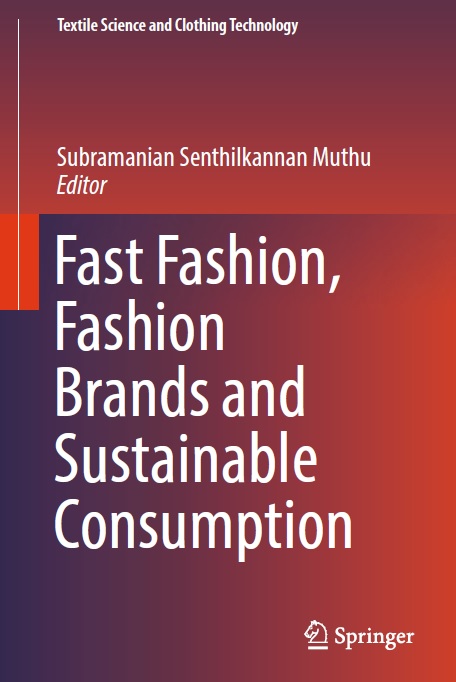By Subramanian Senthilkannan Muthu

Contents
Aline Buzzo and Maria José Abreu
Fast Fashion and Sustainable Consumption . . . . . . . . . . . . . . . . . . . . . . 19
Faustine Binet, Ivan Coste-Manière, Clément Decombes, Yan Grasselli,
Dortmolk Ouedermi and Mukta Ramchandani
Fashion Brands and Consumers Approach Towards
Sustainable Fashion . . . . . . . . . . . . . . . . . . . . . . . . . . . . . . . . . . . . . . . . 37
Asimananda Khandual and Swikruti Pradhan
Fast Fashion, Fashion Brands & Sustainable Consumption
Aline Buzzo and Maria José Abreu
Abstract The phenomenon of fast fashion chains is due to the way this business model manages its production chain and supplies. Combining the quick response to the agile, lean retailing and leagile processes, it is possible to deliver products to retail outlets in a few weeks, in response to growing consumer demand for new goods. The excessive consumption of fast fashion is also due to social media involves issues such as sustainability in fashion consumption and work practices within companies and their suppliers.On the other hand, the awareness of the concernwith the consequences of this consumption gives rise to new ways of consuming and producing fashion causing less impact both environmental and social.
Keywords Fast fashion · Sustainability · Slow fashion · Social media Value chain · Consumption
1 Introduction
The first chapter aims to reveal how the fast fashion business model works and how the processes involved in the production chain deliver new products to stores in a few weeks. The fast fashion concept first emerges in the late 1990s as a way of characterizing the rapid change in fashion and its form of consumption that some companies have begun to adhere to. According to Shimamura and Sanches (2012), “the phenomenon of fast-fashion, even though it is not a novelty in the sector, draws attention to the high profitability achieved and the continuous expansion” since when the model was adopted by major brands in the years 1990. Zara, a Spanish brand belonging to the Inditex group, is today the main representative of this marketing model. Still according to Shimamura and Sanches (2012) speed is an important part of the process, but it is not the only characteristic. In addition to production speed, time, risk and cost must be taken into account in an efficient way. Ciettá (2010) argues that the ability of this system to manage risk-related problems effectively is one of the reasons for its success. The second chapter shows how the arrival of social networks accelerated the consumption of clothing and made them obsolete after being shown on the Internet, as well as the consequences on the consumption behavior of people, since, as Barnes and Lea-Greenwood (2006) explicitly explains, the chains of fast fashion had a negative impact on the environment, since many clothes in these business models are made of plastic fibers. It is important to note the change of habit use of the garments since the arrival of “fast fashion” chains as well as social networks. In a survey of 1500 women aged over 16 years, 33% of respondents said they considered the cloth old after wearing them just over three times, and one in ten women wear a garment only three times before it leave it at the bottom of the wardrobe (Barnardos 2015). It is necessary to take into account other materials used in the fashion industry, such as the metals of the trims, dyes and the entire process that involves the production cycle of a garment until it reaches the consumer, including ethical and labor practices, as it is reported in chapter three.
Sustainability in the textile chain does not end when a garment arrives in stores. It still goes through labor practices and fair trade. India, for example, has the largest workforce in the fashion industry. About 35% of workers earn a salary equivalent to 80% minimum wage (Kerr and Landry 2017). A revolution in the way fashion is consumed is required, since each citizen is not only the audience but also produces, finances, collaborates and disseminates fashion (Carvalhal 2016). The alternatives to the excessive consumption in fashion through the creation of platforms of resales, loans and repairs of clothes are treated in the chapter four and, in chapter 5, the objective is to report how the slow fashion can be an important tool for the consicente consumption in the fashion.
The “slow food” movement, which emerged in Italy in the 1980s as a reaction to the growth of the fast food lifestyle, inspired the concept of “slow fashion” (Clark 2008). According to Fletcher (2007), the factor “time” is not so important in production, since the planning is done in the long term and does not requires subcontracting and temporary workers. In 2007, Hermés handkerchiefs, regarded as timeless and made at reduced speed due to special production techniques, were associated with “slow fashion”. Therefore, many people still assimilate low speed to high-cost products (Deeny 2007). To preserve the natural resources that are consumed globally by the fashion industry, the “slowfashion”movement seeks to promote sustainable innovations, multifunctional and timeless design, reuse of textile materials and services based on alternative strategies such as leasing (or leasing) of fashionable garments and accessories (Angel and Gardetti 2017). Considering both forms of garment consumption, it is easy to deduce that the sustainability in fashion needs to be reflected throughout the textile production chain. Cotton and polyester are high on the list of textile materials most used in the fabric industry, and the polyester demand has doubled in the last 15 years (Fletcher 2013).
